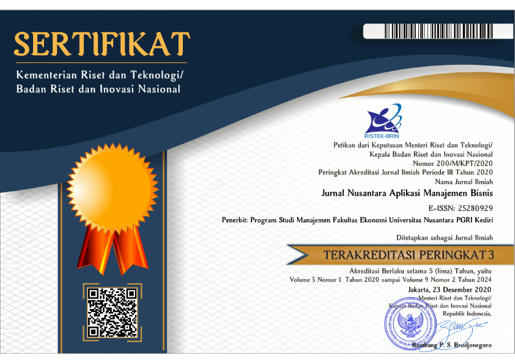Peranan Customer Satisfaction dan Customer Commitment terhadap e-WOM dalam Pengguna Aplikasi Gopay di Yogyakarta
DOI:
https://doi.org/10.29407/nusamba.v6i1.14533Keywords:
kualitas layanan, kualitas produk, promosi, kewajaran harga, loyalitas konsumenAbstract
Customer satisfaction that takes place consistently will make consumers have a commitment to a brand and can further encourage promotion through word of mouth activitie. The purpose of this study was to determine the effect of customer satisfaction on customer commitment, and the impact on consumer commitment to do e-wom activities. This research uses Gopay service as the research object and gender as the moderating variable. With the survey method on 377 respondents and the structural model testing hypotheses process, the results show that consumer satisfaction has a positive effect on consumer commitment, and consumer commitment has a positive effect on e-WOM activities; while gender is proven to moderate the relationship between these variables.
Downloads
References
Adi, F., Sumarwan, U., & Fahmi, I. (2018). Pengaruh Faktor Sikap, Norma Subjektif, Demografi, Sosioekonomi serta Literasi Keuangan Syariah dan Konvensional terhadap Minat Berwirausaha pada Mahasiswa. Al-Muzara’ah, 5(1), 1–20. https://doi.org/10.29244/jam.5.1.1-20
Alkilani, K., Ling, K. C., & Abzakh, A. A. (2012). The impact of experiential marketing and customer satisfaction on customer commitment in the world of social networks. Asian Social Science, 9(1), 262–270. https://doi.org/10.5539/ass.v9n1p262
Bansal, H. S., Irving, G., & Shirley, F. (2004). A three-component model of customer commitment to service providers. Journal of the Academy of Marketing Science, 32(3), 234–250. https://doi.org/10.1177/0092070304263332
Čater, T., & Čater, B. (2010). Product and relationship quality influence on customer commitment and loyalty in B2B manufacturing relationships. Industrial Marketing Management, 39(8), 1321–33.
Çera, G., Cepel, M., Zakutna, S., & Rozsa, Z. (2018). Gender differences in perception of the university education quality as applied to entrepreneurial intention. Journal of International Studies, 11(3), 147–160. https://doi.org/10.14254/2071-8330.2018/11-3/13
Chan, Y., & Ngai, E. W. T. (2011). Conceptualising electronic word of mouth activity: An input-process-output perspective. Marketing Intelligence & Planning, 29, 488–516. https://doi.org/10.1108/02634501111153692
Evanschitzky, H. Ramaseshan, B. Woisetschläger, D. M. (2011). Consequences of customer loyalty to the loyalty program and to the company. Journal of the Academy of Marketing Science, 40, 625–638. https://doi.org/10.1007/s11747-011-0272-3
Fullerton, G. (2011). Creating advocates: The roles of satisfaction, trust and commitment. Journal of Retailing and Consumer Services, 18(1), 92–100.
Goyette, I., Ricard, L., Bergeron, J., & Marticotte, F. (2010). e-WOM scale: Word-of-Mouth measurement scale for e-services context. Canadian Journal of Administrative Sciences, 27, 5–23. https://doi.org/10.1002/CJAS.129
Hair, J. F., William C, B., Babin, B. J., & Anderson, R. E. (2014). Multivariate Data Analysis. Pearson.
Jalilvand, M. R., & Samiei, N. (2012). The effect of electronic word of mouth on brand image and purchase intention: An empirical study in the automobile industry in Iran. Marketing Intelligence and Planning, 30(4), 460–476. https://doi.org/10.1108/02634501211231946
Kotler, P., & Keller, K. L. (2016). Marketing Management, 16 ed.. Pearson.
Lee, Z. W.-Y., & Cheung, C. M.-K. (2014). Problematic Use of Social Networking Sites: The Role of Self-Esteem. International Journal of Business and Information, 9(2), 143–159.
Moran, G., & Muzellec, L. (2017). eWOM credibility on social networking sites: A framework. Journal of Marketing Communications, 23(2), 149–161. https://doi.org/10.1080/13527266.2014.969756
Nusair, N., Ababneh, R., & Bae, Y. K. (2012). The impact of transformational leadership style on innovation as perceived by public employees in Jordan.International. Journal of Commerce and Management, 22(3), 182–201.
Oktaviani, N., Astuti, W., & Firdiansjah, A. (2019). PENGARUH KEPUASAN KONSUMEN TERHADAP PEMBENTUKAN KOMITMEN PELANGGAN DAN e-WOM PADA PENGGUNA APLIKASI e-MONEY “OVO.” Jurnal Manajemen Dan Pemasaran Jasa, 12(1), 93. https://doi.org/10.25105/jmpj.v12i1.3757
Purnasari, H., & Yuliando, H. (2015). How Relationship Quality on Customer Commitment Influences Positive e-WOM. Agriculture and Agricultural Science Procedia, 3, 149–153. https://doi.org/10.1016/j.aaspro.2015.01.029
Rahmawaty, A. (2011). PENGARUH SERVICE PERFORMANCE, KEPUASAN, TRUST DAN KOMITMEN TERHADAP LOYALITAS NASABAH DI BANK SYARI’AH MANDIRI KUDUS. INFERENSI, Jurnal Penelitian Sosial Keagamaan, 5(1), 53–80.
Renfree, I., Harrison, D., Marshall, P., & Stawarz, K. (2016). Don’t kick the habit: The role of dependency in habit formation apps. Dl.Acm.Org, 1. https://dl.acm.org/citation.cfm?id=2892495
San-Martín, S., Prodanova, J., & Catalán, B. L. (2016). What makes services customers say “buy it with a mobile phone”? Journal of Services Marketing, 30(6), 601–614.
Serra-Cantallops, A., Ramon-Cardona, J., & Salvi, F. (2018). The impact of positive emotional experiences on eWOM generation and loyalty. Spanish Journal of Marketing - ESIC, 22(2), 142–162. https://doi.org/10.1108/SJME-03-2018-0009
Setiawan, H., & Sayuti, A. J. (2017). Effects of service quality, customer trust and corporate image on customer satisfaction and loyalty: an assessment of travel agencies customer in South Sumatra Indonesia. IOSR Journal of Business and Management, 19(5), 31-40.
Soliana, D. S., & Pratomo, L. A. (2016). ANTESEDEN DARI WORD OF MOUTH. Jurnal Ekonomi, 7(01), 1–10.
Stan, V. (2015). Does Consumer Gender Influence The Relationship Between Consumer Loyalty And Its Antecedents? Journal of Applied Business Research, 31(4), 1593–1604. https://doi.org/10.19030/jabr.v31i4.9339
Sumaedi, S., Juniarti, R. P., & Bakti, I. G. M. Y. (2015). Understanding trust & commitment of individual saving customers in Islamic banking: The role of ego involvement. Journal of Islamic Marketing, 6(3), 406–428. https://doi.org/10.1108/JIMA-06-2013-0045
Syahrivar, J., & Ichlas, A. (2018). The Impact of Electronic Word of Mouth (E-WoM) on Brand Equity of Imported Shoes: Does a Good Online Brand Equity Result in High Customers’ Involvements in Purchasing Decisions?. (AJTM). 11. 57-69. 10.12695/ajtm.2018.11.1.5. The Asian Journal of Technology Management, 11(1), 57–69. https://doi.org/10.12695/ajtm.2018.11.1.5
Teo, R., & Soutar, G. (2012). Word of mouth antecedents in an educational context: A Singaporean study. International Journal of Educational Management, 26(7), 678–695. https://doi.org/10.1108/09513541211263746
Wang, T., Yeh, R. K. J., Chen, C., & Tsydypova, Z. (2016). What drives electronic word-of-mouth on social networking sites? Perspectives of social capital and self-determination. Telematics and Informatics, 33(4), 1034–1047. https://doi.org/10.1016/j.tele.2016.03.005
Wirtz, J., & Chew, P. (2002). The effects of incentives, deal proneness, satisfaction and tie strength on word-of-mouth behaviour. International Journal of Service Industry Management, 13(2), 141–162. https://doi.org/10.1108/09564230210425340
Yaqub, M. Z., Malik, A., & Shah, H. (2015). The roles of satisfaction, trust and commitment in value-creation in strategic networks. European Journal of Economics, Finance and Administrative Sciences, 18(1), 133–145.
Downloads
Published
Issue
Section
License
Authors who publish with this journal agree to the following terms:
- Copyright on any article is retained by the author(s).
- The author grants the journal, the right of first publication with the work simultaneously licensed under a Creative Commons Attribution License that allows others to share the work with an acknowledgment of the work’s authorship and initial publication in this journal.
- Authors are able to enter into separate, additional contractual arrangements for the non-exclusive distribution of the journal’s published version of the work (e.g., post it to an institutional repository or publish it in a book), with an acknowledgment of its initial publication in this journal.
- Authors are permitted and encouraged to post their work online (e.g., in institutional repositories or on their website) prior to and during the submission process, as it can lead to productive exchanges, as well as earlier and greater citation of published work.
- The article and any associated published material is distributed under the Creative Commons Attribution-ShareAlike 4.0 International License












